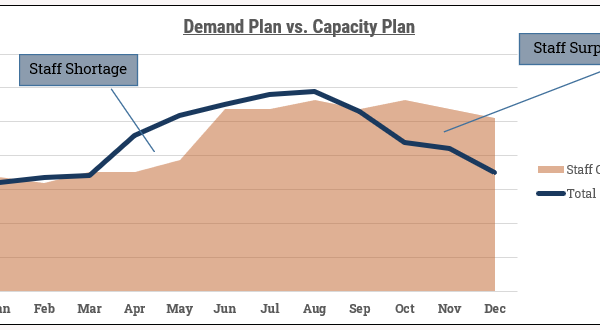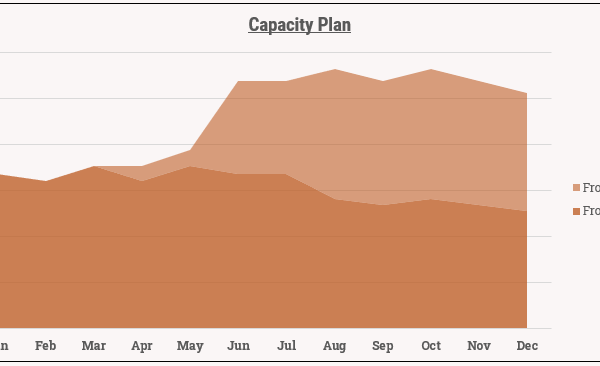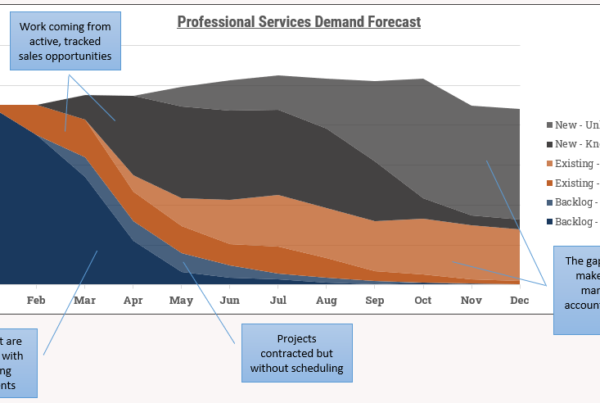“It’s tempting for project teams to prepare neatly organized project plans where every team member works exactly 40 hours a week and the project is done exactly on the due date. Do you need to apply discretion to the numbers to account for slippage?”
Half way there
As we saw in our demand planning post, a big part of our Professional Services demand plan is the backlog. Our active backlog is the list of ongoing projects; (1) those currently in flight or (2) those that are contracted and waiting to start. These projects make up almost all of our short-term revenue (and depending on project size, maybe medium and long-term as well). This is good news, half of our forecast is right there at our fingertips! The bad news is that extracting this information and trusting that it’s reliable can be a challenge.
The Basic
The trick is to have a backlog that is large enough to sustain our full-time staff and financial targets, while still small enough that customers aren’t being impacted by staffing shortages and missed deadlines.
Forecasting our backlog requires certain information:
- What are the active projects?
- What work tasks are scheduled?
- When are they scheduled?
- What person or what role is assigned on these tasks?
- What other work is outstanding on the project that is yet to be scheduled?
How do services firms manage their projects?
I have seen five broad categories of tools for managing active projects:
- Excel / Google Sheets / Email / Offline
- Project management software
- Professional services automation (PSA) software
- Industry-specific practice management software
- FP&A software
1. Excel / Google Sheets / Email / Other
These are typical in smaller or early stage companies, or where services is not the core line of business. Ironically also common in very large companies where these tools round out a patchwork of different legacy systems in place.
Pros
- Highly flexible and can be deployed to any situation
- Empowers the end-user to work the way they know best
Cons
- No standardization makes it hard to enforce consistency across the organization
- Hard to collaborate with teammates
- Leaders can’t easily see the project overall portfolio
- Disconnected from other systems
2. Project Management tools
These are purpose-built tools like Monday.com, Asana, Smartsheet, and Trello. They are almost entirely cloud-based and follow SaaS methodology of quick deployment and minimal implementation time.
Pros
- Slick interfaces with Gantt charts, Kanban boards, and a user-friendly experience
- Great collaboration functionality and integration with e-mail and social tools
Cons
- Most of these tend to be aimed at internal projects and lack project accounting features, contract management, resources management, CRM capabilities, etc.
- Can be inflexible
3. Professional Services Automation tools (PSA)
These are intended to be all-inclusive platforms that help you manage your professional services firm, from sales to project delivery to accounting. Examples include Kimble, Projector, Mavenlink, Connectwise, and Autotask.
Pros
- Project management, resource management, timesheets
- Project accounting modules (revenue and cost) and contract management
- Value-add functionality like baseline CRM, quoting and estimates, ticketing.
Cons
- Tend to be rigid and inflexible
- Can be cumbersome to use
- Since the platform is so broad, some of the functionality can to be half-baked or underdeveloped (it’s hard to do everything well!)
4. Industry-specific practice management software
Similar to the more generic PSA tools, these are all-inclusive platforms aimed at a specific industry niche. Law firms may leverage platforms such as Clio and Moxtra, while accounting firms may looks to platforms such as BigTime, QBE Core, and Karbon.
Pros
- Purpose built
- Very relevant to the industry
Cons
- Can still be inflexible
- Obviously limited appeal across the broader professional services industry
5. FP&A / CPM Software
Can be used for financial and operational planning and reporting at the project, customer, or portfolio level.
Pros
- Great for forecasting and reporting on work effort and project financials
- Very customizable
- Integrates well with the rest of the FP&A solution
Cons
- Does not mimic modern project management capabilities
- Does not cover timesheets, CRM, ticketing, or other PSA functionality
Of course, it’s not uncommon for a company to combine several of these together. A company that manages large-scale projects that take years to complete may have a configuration like this:
- The project team uses a combination of the first two items to manage the day-to-day project operations
- The services team as a whole uses a PSA tool for overall resource management, timesheets, contract management, and project accounting
- The finance team uses the FP&A / CPM tool to create the financial and operational forecast for the overall business
Forecasting your Backlog
Does your PSA provide you with a full weekly or monthly revenue plan, labor cost, and hours forecast by role for all your active projects?
If it does… great! Load this result into your FP&A Software and you’ve got a huge part of your demand plan ready to go! Just a few considerations for you:
- Do you have any unscheduled backlog? You’ll need to put a provision in for this work getting started or else you’ll underestimate true headcount needs.
- How realistic are your work schedules right now? Optimism bias can run rampant when it comes to project-based work. It’s tempting for project teams to prepare neatly organized project plans where every team member works exactly 40 hours a week and the project is done exactly on the due date. Do you need to apply discretion to the numbers to account for slippage?
In many cases, you will need to approximate your revenue and cost plan. Visualize something like this:

Here we have some key data points for each project:
- The number of contracted hours, typically matches to a SOW plus any change orders.
- The number of hours the team has worked, coming from your timesheet system.
- The backlog hours; the number of hours remaining on the contract.
- The start date of the project. This is critical for projects that haven’t started yet.
- Some measure for project pace or velocity. Here we used “Hours per Month” as a measure of how quickly the project is moving.
Based on these data points, we can calculate how much work will be done each month. Note that this is shown as a straight-line forecast where work is consistent every month but you can consider calculating it based on a curve instead if you have front-loaded, back-loaded, or other irregular pacing.
We’re looking at this by project, but the next extension is to look at it by role as well. Since your customer-facing services business is likely made up of more than one type of job position, it’s critical to understand the roles in most demand.
Closing Thoughts
Forecasting your backlog is a critical part of your demand plan because it’s so immediate and has such a large impact. Being able to pinpoint when you’ll have shortfalls in weeks or months before they happen will give you the adequate lead time to drum up more business or take mitigating steps. Of course, we haven’t mentioned yet, the success and accuracy of your financial plan is going to be tied to the grassroots operational effectiveness of your organization. Your project teams need to be diligent and rigorous about managing timelines and reacting to changes and they need to use the tools provided to ensure full collaboration. Garbage in, garbage out, as the idiom goes. With operational effectiveness in mind and with a keenly honed planning methodology and process, you’ll be well on your way to a repeatable and accurate forecast.






